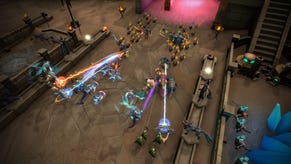Cerny: Blockbuster game economics no longer make sense
With tech evolution stalled, now's the time to reassess budget sizes, says 30-year vet
Mark Cerny, 30-year veteran of arcade and console game development, told the audience of the DICE Summit today that the economics of the blockbuster videogame business no longer make sense.
Not only have costs risen to new highs, in order for businesses to hire new team members they have to make others redundant to balance the costs, said Cerny.
"We've had ten years where every year that went by the industry got bigger and more successful. But the natural growth has now gone. In fact, now that we're in decline if you want to add a person to your team to make the local industry economics add up, someone else has to layoff something like a person and a half.
"And there aren't many of these high budget games. Last year there were only about 50 or 60 games that sold over a million units - that's multiplatform and international. And only half only sold two million. Of course if you spend over $20 million you want to sell a million units. And if you spend over $50 million you want something well north of two million unit sales."
Cerny said that only six years ago a blockbuster console game would cost around $20 million rather than $50 million to make - but asked was it possible to reduce costs to that level now that the industry is used to spending $50 million?
"Frankly, the economics of the $50 million game are looking a little shakey. By contrast with a $20 million game I'm pretty sure I can make that money back - multiplatform, international distribution. But that raises the question, can we make the $20 million game?
"Historically, we never had much money to spend. Can we do it? Maybe not. The problem is we've learned how to spend the money. If I go back to 1994 and somebody says 'here's $20 million to spend' I would have absolutely no idea what to do with that money."
"We had no specialisation what-so-ever in 1994," he continued. "In 2011 we have the creative director, the game director, the director of actors, stunt co-ordinator, the guy who makes the plywood props, the audio scripter, the lighting designer, and the most recent of creations - the combat designer.
"If you say to your team we only have two combat designers, what you're going to hear is 'that game's going to suck'".
But Cerny said that with no new consoles on the horizon, now was the perfect time to assess the costs of game development, reduce spend, and take the time to refine the craft of games creation.
"We are in a very rare time now. Technology is not changing. It's a quiet time and they don't happen very often. We have a revolution every five years and we have to go so many hoops just to make games for a next generation.
Transitions from one generation to the next can be "brutal" Cerny said. "I'm sure all of you will remember, it's been tough going to the modern consoles. Every team I worked with wasted - or spent - at least a year mastering the transition."
"But now it looks like we're done. Unless a new wave of consoles come out... we're done. And that means we can take our time and to learn our craft. To learn what is important to spend money on. And get out of the spiral where we spend $5 million more every year making that next title.
"And at the same time bring back that diversity and excitement, because that's what is going to keep the industry growing," he concluded.








